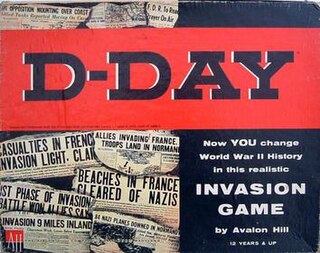
D-Day is a board wargame published by Avalon Hill in 1961 that simulates the six months of the European Campaign of World War II from the Normandy Invasion to the crossing of the Rhine. It was the first wargame to feature the now ubiquitous hex grid map and cardboard counters, and was revised and re-released in 1962, 1965, 1971, 1977 and 1991.
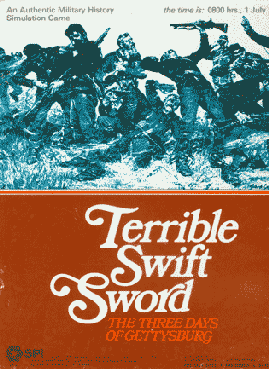
Terrible Swift Sword: Battle of Gettysburg Game is a grand tactical regimental level board wargame published by Simulations Publications, Inc. (SPI) in 1976 that simulates the Battle of Gettysburg during the American Civil War. A second edition was published by TSR in 1986.

Napoleon's Last Battles is a board wargame published by Simulations Publications in 1976 that simulates the last four battles fought by Napoleon. It was one of SPI's most popular games, and also received many positive reviews.
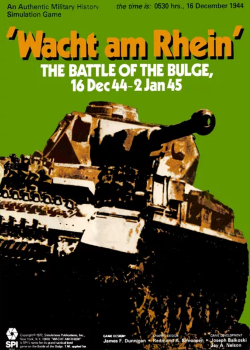
Wacht am Rhein is a grand tactical monster board wargame published by Simulations Publications, Inc. (SPI) in 1977 that simulates Germany's Battle of the Bulge offensive in late 1944 during World War II.

The Battle of Borodino: Napoleon in Russia 1812 is a board wargame published by Simulations Publications Inc. (SPI) in 1972 that is a simulation of the Battle of Borodino during the French invasion of Russia in 1812.

Frederick the Great, subtitled "The Campaigns of The Soldier King 1756–1759", is a board wargame published by Simulations Publications Inc. (SPI) in 1975 that simulates several of the campaigns of Frederick the Great in Central Europe during the Seven Years' War. When SPI ran into financial difficulties, they sold the rights to the game to Avalon Hill, who produced a second edition in 1982.

La Grande Armée, subtitled "The Campaigns of Napoleon in Central Europe", is a board wargame published by Simulations Publications Inc. (SPI) in 1972 that simulates three campaigns of Napoleon.

Lee Moves North, originally titled Lee at Gettysburg and subtitled "The Confederate Summer Offensive, 1862 & 1863", is a board wargame published by Simulations Publications Inc. (SPI) in 1972 that simulates Robert E. Lee's summer offenses of 1862 and 1863 during the American Civil War

MechWar '77, subtitled "Tactical Armored Combat in the 1970s", is a board wargame published by Simulations Publications Inc. (SPI) in 1975 that simulates hypothetical tank combat in the mid-1970s between various adversaries, using the same rules system as the previously published Panzer '44.

Musket & Pike, subtitled "Tactical Combat, 1550-1680", is a board wargame published by Simulations Publications Inc. (SPI) in 1973 that simulates combat in Europe during the transition from edged weapons to firearms in the 16th and 17th centuries.

Napoleon at War, subtitled "Four Battles", is a collection of four board wargames published by Simulations Publications Inc. (SPI) in 1975 that simulates various battles fought by Napoleon.

Napoleon at Waterloo is a board wargame published by Simulations Publications Inc. (SPI) in 1971 that simulates the Battle of Waterloo. The game, which features simple rules, was designed as an introduction to board wargaming, and was given as a free gift with each subscription to SPI's Strategy & Tactics magazine.

Rocroi, subtitled "19 May 1643 – The End of Spanish Ascendancy", is a board wargame published by Simulations Publications Inc. (SPI) in 1976 that simulates the 1643 Battle of Rocroi during the Thirty Years' War. Rocroi was originally sold as one of four separate games packaged together in Thirty Years War, a "quadrigame", but it was also published as an individual game. It received mixed reviews from critics, some of whom called it a "bland tactical problem", while others declared it was the best game of the four in the Thirty Years War box.

Breitenfeld, subtitled "Triumph of the Swedish System", is a board wargame published by Simulations Publications Inc. (SPI) in 1976 that simulates the 1631 Battle of Breitenfeld during the Thirty Years' War. Breitenfeld was a free game that appeared in Strategy & Tactics, designed to promote SPI's soon-to-be-launched wargame Thirty Years War. Breitenfeld proved popular and was also published as part of SPI's "folio" series of games.
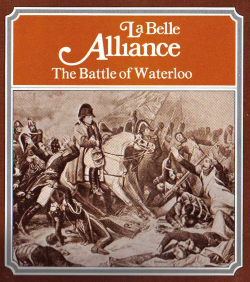
La Belle Alliance: The Battle of Waterloo is a board wargame published by Simulations Publications Inc. (SPI) in 1976 that simulates the Battle of Waterloo in 1815. It was one of four games that were published as part of the "quadrigame" titled Napoleon's Last Battles, but was also released as an individual "folio game", packaged in a shrinkwrapped cardboard folio.

Spitfire, subtitled "Tactical Aerial Combat in Europe 1939-42", is a board wargame published by Simulations Publications Inc. (SPI) in 1973 that simulates aerial combat during World War II.
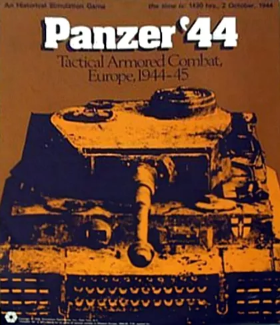
Panzer '44: Tactical Combat in Western Europe, 1944–45 is a board wargame published by Simulations Publications Inc. (SPI) in 1975 that simulates historical tank combat during World War II.

Ligny: Incomplete Victory is a board wargame published by Simulations Publications Inc. (SPI) in 1976 that simulates the Battle of Ligny. Ligny was originally published as one of four games in the popular collection Napoleon's Last Battles, but was also released as an individual game.

Strike Force One, subtitled "The Cold War Heats Up — 1975", is a board wargame published by Simulations Publications Inc. (SPI) during the Cold War in 1975 that simulates a hypothetical clash in West Germany between Soviet Union invaders, and American defenders. The short and simple game was designed as an introduction to the hobby of wargaming, and was given away as a free promotional item.

Waterloo is a Napoleonic board wargame published by Avalon Hill in 1963 that simulates the Battle of Waterloo. It was one of the first board wargames produced and despite its lack of historicity and complexity, it still received positive comments more than twenty years later as a fun and playable game, and remained in Avalon Hill's catalogue until 1990.




















